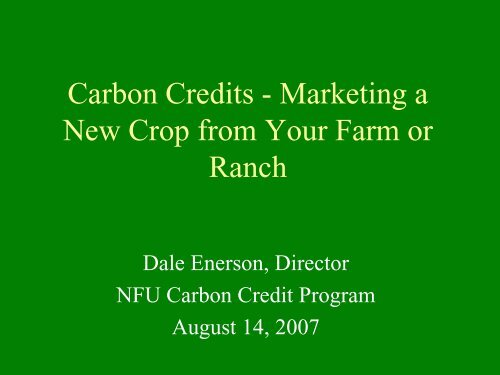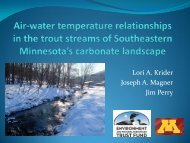Create successful ePaper yourself
Turn your PDF publications into a flip-book with our unique Google optimized e-Paper software.
<strong>Carbon</strong> <strong>Credits</strong> - Marketing a<br />
New Crop from Your Farm or<br />
Ranch<br />
Dale Enerson, Director<br />
NFU <strong>Carbon</strong> Credit Program<br />
August 14, 2007
<strong>Carbon</strong> <strong>Credits</strong> - Why Now<br />
• Climate change and our nation’s reaction is in the<br />
news<br />
• Renewable Energy issues and higher priced fossil<br />
fuels are related<br />
• <strong>Carbon</strong> prices doubled in 2006 on the CCX, have<br />
remained steady recently<br />
• Iowa Farm Bureau and North Dakota/National<br />
Farmers Union are major aggregators for the CCX<br />
• 2007 Farm bill debate includes discussions of<br />
climate issues and conservation payments
Agriculture’s Role…<br />
• It is estimated that U.S. agriculture could<br />
sequester 275 -900 million tons of carbon dioxide<br />
annually.<br />
• Dr. Richard Sandor (CCX Founder) estimated<br />
future value of agricultural offsets at up to $20<br />
Billion annually<br />
• Agriculture could be the “bridge” to climate<br />
stabilization in the coming years at a much<br />
cheaper cost than some of the big technology ideas<br />
like underground or ocean storage.
<strong>Carbon</strong> Sequestration<br />
• <strong>Carbon</strong> sequestration can be defined as the capture and<br />
secure storage of carbon that would otherwise be emitted<br />
to or remain in the atmosphere.<br />
• What are <strong>Carbon</strong> <strong>Credits</strong><br />
– <strong>Carbon</strong> credits encompass two ideas:<br />
(1) Prevention/reduction of carbon emissions produced by human<br />
activities from reaching the atmosphere by capturing and diverting<br />
them to secure storage.<br />
(2) Removal of carbon from the atmosphere by various means and<br />
securely storing it.
Value of Increasing SOM (Soil<br />
Organic Matter)<br />
• Improves soil structure<br />
• Decreases erosivity<br />
• Increases infiltration<br />
• Increases soil water holding capacity<br />
• Increases cation exchange capacity<br />
• Decreases the energy requirement for<br />
cultural operations
An acre of land could produce:<br />
• Income from the sale of a grain crop<br />
• Income from a government crop subsidy<br />
• Income from the lease or sale of minerals<br />
under the surface<br />
• Income from recreational uses<br />
• Income from the wind development rights<br />
• Income from the storage of carbon
NFU <strong>Carbon</strong> Credit Program<br />
• No-till cropping (.2-.6 metric tons per acre annually) (No beginning<br />
date)(Includes alfalfa planted in rotation)<br />
• Seeding long term grasses 1.0 metric tons per acre)(Other seeded<br />
grasses, CRP) (Has to be planted after 1-1-1999)<br />
• Enhanced range management with increased vegetative index (.12-<br />
.52 metric tons per acre) (Cell grazing,rotational, intensive grazing<br />
practices)<br />
• Forestry offsets (1.5-7 tons per acre annually) (Available in all<br />
states)(Have to be planted after 1990)<br />
• Methane Capture (anaerobic digesters from livestock wastes - [1 ton<br />
methane =18 tons carbon credits])<br />
• Restoring wetlands (not approved yet and maybe won’t be anytime<br />
soon)(up to 4.5 tons)(concerns over other emissions, notably methane<br />
and nitrous oxide)
What’s It All Worth<br />
• Total about<br />
$3,000,000 to 1230<br />
farmers in the first<br />
NDFU/NFU pool<br />
• That will average<br />
about $2400 per farm<br />
and will range from<br />
about $60 to about<br />
$24,000.<br />
• 2007 enrollments (Sept 15<br />
deadline for no-till and<br />
grass offsets) will add<br />
substantially to total acres,<br />
and increased rangeland<br />
and forestry could<br />
generate millions of<br />
additional dollars to be<br />
paid in 2008.
What’s It Worth to Me<br />
• No-till, Strip-till, and alfalfa in central and<br />
northwestern Minnesota at .4 tons is about<br />
$1.25/acre<br />
• Seeded grasses (CRP) at 1 ton is just over $3.00<br />
per acre<br />
• Forestry offsets (planted trees or regenerated trees)<br />
can be up to $8-12 per acre<br />
• All carbon contracts specify only tons, and the<br />
price is determined at the time of each year’ sale<br />
of the pooled credits.
Expanded No-till Eligible Areas<br />
• Central and eastern US has several zones ranging<br />
from .2 tons to .6 ton per acre annually. Minnesota<br />
eligible area was expanded in April to all of the<br />
state.<br />
• Similar restrictions as previously with limits on<br />
low-residue crops in rotation (soybeans)<br />
• Ridge Till is not permitted, even though some<br />
aggregators allowed this earlier. Strip till is<br />
permitted with less than third of surface area<br />
disturbed.<br />
• Has to be continuous no-till or strip-till in the<br />
same field, not rotations to different parts of the<br />
farm.
New Eligible Areas<br />
• NFU/NDFU website has new map area and<br />
new contract for enrollment.<br />
• Only one contract for all areas and only one<br />
contract covering 2006-2010 period<br />
• Now offering choice of entering land<br />
descriptions by text version in all states, and<br />
trial of new Internet mapping entry system<br />
in North Dakota
“No-till’ Definitions<br />
• General rule of thumb: direct seeding with no more than<br />
30% surface area disturbance (3” wide openers on a 10”<br />
shank spacing)<br />
• Strip till is allowed with no more than 30% soil<br />
disturbance (10” wide tilled strips on a 30” row spacing,<br />
no in-crop row cultivation, but separate knife fertilizer<br />
applications are allowed<br />
• Disc type openers in most any row spacing are least<br />
disturbance, but are not required.<br />
• Guidelines reference NRCS STIR ratings of 20 or less
Forestry Offsets<br />
• Trees have to be planted (not native stands)<br />
after January 1, 1990<br />
• Series of “lookup” tables from CCX using<br />
age, species, locale, density, and etc.<br />
• In initial applications, we estimate the rate<br />
using CCX tables, then farmer decides<br />
whether to enroll<br />
• Sample contract and worksheets on nfu.org
Methane Capture<br />
• <strong>Carbon</strong> credits are earned for the capture of<br />
methane from livestock waste systems, either just<br />
covered lagoons or anaerobic digesters.<br />
• Each ton of methane captured earns 18 tons of<br />
carbon dioxide credits which can be sold on CCX.<br />
• Estimate at today’s carbon price about $30 per<br />
dairy cow, additional revenue if methane can be<br />
used to produce electricity.<br />
• Projects can be anywhere in US.
How Do I Get Into This<br />
Soils Offsets (No Till and Grass)<br />
• “Enroll” option on www.nfu.org, www.mfu.org or<br />
ndfu.org website.<br />
• Enter farm information and enter land descriptions<br />
into the on-line database.<br />
• Download, print contract from the web.<br />
• Send signed contract, copies of maps, and CCC-<br />
578 forms to NFU.<br />
• Send annual certification form to NFU<br />
• Cash the first check next year !!!
How Do I Get Into This<br />
(Range, Forestry, Methane)<br />
• Go to nfu.org or ndfu.org to download sample<br />
contracts and worksheets<br />
• Enter data on the worksheets as accurately as<br />
possible<br />
• Send worksheets and other required materials to<br />
NFU<br />
• We will estimate the rate and proposed contract<br />
and then will contact producers<br />
• Depending on number of contracts, may have<br />
several payment periods<br />
• Forestry offsets can be paid back to 2003 if<br />
eligible.
Verification of CCX contracts<br />
• CCX randomly selects at least10% of our contracts for<br />
verification.<br />
• This is crucial to our program. We have to have the<br />
reputation of having high quality, true offsets.<br />
• Without this step, buyers will question the purchase of<br />
agricultural offsets, and the whole system of “cap and<br />
trade” fails.
Verification of Contracts…<br />
• Chicago Climate Exchange contracted with ND Association of Soil<br />
Conservation Districts for verification of 104,000 acres in our carbon<br />
program. (10% of contracts, not acres)<br />
• North Dakota in-field contract verifications were conducted and<br />
completed by Christmas - Less than 800 acres out of 800,000 had any<br />
eligibility problems!<br />
• Other states have completed verifications by various private companies<br />
and soil conservation districts. (Overall results good, but some<br />
problems with grass/forage seeding date)
Future Potential<br />
• Relatively low prices for stored carbon up until recent months caused<br />
many producers to feel it was not worth the effort to enroll, but the $3-<br />
5 price caused some interest.<br />
• US political climate and concern for environmental issues will<br />
determine success of this project<br />
• There are millions of acres of cropland, rangeland, forests and<br />
wetlands in the US, and relatively few are managed for carbon<br />
sequestration objectives as of now. Farm bill and other considerations<br />
will determine how many acres will fit carbon credits programs.<br />
• Manure digesters, renewable energy projects will also offer<br />
opportunities.<br />
• Realistically, even if we could achieve enough income to pay real<br />
estate taxes, that would be a huge impact to rural economies. ($3-10<br />
per acre)
Downside<br />
• Other farm groups will see this as another threat to<br />
property rights (no easements, no recordings)<br />
• While general public has been shown to support reducing<br />
greenhouse gas emissions, many individuals see this as a<br />
threat to business<br />
• Coal fired energy industry and to some extent rural electric<br />
cooperatives see greenhouse gas discussions as a threat,<br />
but are planning to adapt to coming cap and trade plans.<br />
• Fear of selling credits now when they may be worth more<br />
later (credits are priced in the future)<br />
• Producers not fulfilling contracts if prices drop.<br />
• May complicate landlord-tenant negotiations.
Future NFU <strong>Carbon</strong> Website…<br />
• As we add more eligible territory for soils offsets, range<br />
management, and forestry, we plan to make the on-line<br />
enrollment easier.<br />
• We are working with our programmer to have an on-line<br />
internet mapping system to avoid typing in land<br />
descriptions. Instead, producers will simply click on the<br />
land tract (Common land units {CLU}) and the acreage<br />
will automatically add to the database. The initial trial<br />
version on this is up and running for North Dakota.
QuickTime and a<br />
H.264 decompressor<br />
are needed to see this picture.<br />
(Leaps tall stubble in a single bound! Sequesters carbon with his bare hands! <strong>Carbon</strong> bullets bounce off his impenetrable skin. When he passes gas it of course contains no<br />
methane!!! He's <strong>Carbon</strong> Man!!! Raised by a farm family from western North Dakota, most of his days are spent as the meek and mild mannered Farm Economist Dale Enerson. But<br />
when the need arises, he ducks into a nearby VW Beetle and emerges that hero of heroes <strong>Carbon</strong> Man!!! )
It’s Now Time to STOP!
www.mfu.org or www.nfu.org or www.ndfu.org<br />
or 1-800-366-8331 ext.116
















